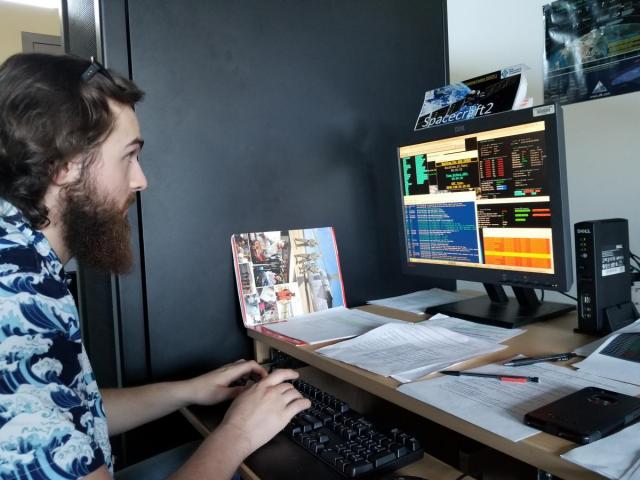Inside Our Space Flight Operations Training Center
July 15, 2019By Laura Dugan ’03
Marcel Mabson graduated from Capitol in 2010, with a degree in Astronautical Engineering (AE). Now a software test engineer for The Hammers Company and an adjunct professor in Capitol’s Astronautical Engineering program, he offers insight into the university’s Space Flight Operations Training Center (SFOTC).
Which degree programs utilize the SFOTC?
MM:The primary program is the B.S. in Astronautical Engineering; however, students from other majors can take electives and use the SFOTC. It is set up to be multidisciplinary for training all of the majors. We recently had a couple students from the cybersecurity program ask to use the SFOTC to run tests, which will occur in the fall.
What makes the SFOTC unique?
MM:We have five spacecraft available to allow students to have a real-world experience commanding a spacecraft that contains real software from a NASA mission. The spacecraft responds just like it would on orbit. Unlike real missions where you may only be in contact with the spacecraft for a limited amount of time, because we are simulating these experiences, we can be in contact with a spacecraft at any time or we can mimic a real-life environment.
How can students’ careers benefit from the SFOTC?
MM: Because we are flying actual spacecraft, when it comes time to train students in anomalies recovery, the professor can inject failures into the simulation while it’s running. We can see how well that student identifies the problem and then uses their skills to resolve it. As far as I know, we are the only university that is doing this. Other universities may fly live missions, but we can train in both routine and anomaly situations, so students are getting more real-life experience before they enter the workforce.
The SFOTC uses industry standard software and most missions at NASA Goddard Space Flight Center are using the same software, so if you are a mission director and you’re looking for students coming in to that environment, you don’t have to train them on the software. They already have the expertise. The students only need to be trained on what makes the spacecraft unique.
What is the SFOTC’s relationship with NASA?
MM: We’ve had six graduates that got their jobs in operations because they worked in the SFOTC. All six students are working at NASA Goddard. We asked the managers why they hired the students, and their response was that they know how to speak like controllers. When we had them talking to other engineers, they had the language down like they’d been talking about it for five or six years.
Additionally, we’ve had employers, such as NASA, ask us to add elements into the curriculum. The team behind the James Webb telescope, a project with which Capitol Tech’s Astronautical Engineering students are assisting, said we were giving them great students, but they didn’t have a lot of experience with voice suite protocol. We updated one of our courses to address their request.
What is one thing you want prospective students to know about the SFOTC?
MM:Because we place students into an operations-like environment, by the time students reach the end of their junior year, they are working on spacecraft in a way that mimics the work environment. There are also opportunities to learn which area of focus is best for you. We’re going to train you just like NASA trains their new controllers. You may find that you don’t like a certain subsystem, but because we’re a control center, we will find you a system you enjoy and excel in.
What is one thing you want current students to know about the SFOTC?
MM: A lot of the students at Capitol have never seen the SFOTC except during tours. We would like current students to know that this is not just for AE students. If you are interested in learning about electrical engineering or programming, the SFOTC covers all of these fields with the spacecraft. If you want more exposure for your career path, the SFOTC can contribute to your learning experience through electives and that helps you to expand your knowledge.
How does the SFOTC stay up to date?
MM:Because all of our alumni work in operational environments, we receive emails from former students who have experienced an anomaly at work, and we take that information and share it with current students. Company partnerships also allow for up-to-date technology. The Hammers Company, which provided the initial donation to fund the SFOTC, is coming back to provide new software called Stars, which will allow us to process and trend spacecraft data. We also have a partnership with Titus software, and they will be providing us with discounts on mission planning software. We always strive to keep the center fresh and up to date so that it provides the most benefit to students.
Want to learn more about astronautical engineering? Capitol offers bachelor’s programs in Astronautical Engineering and Unmanned and Autonomous Systems. Contact admissions@captechu.edu to learn more.



